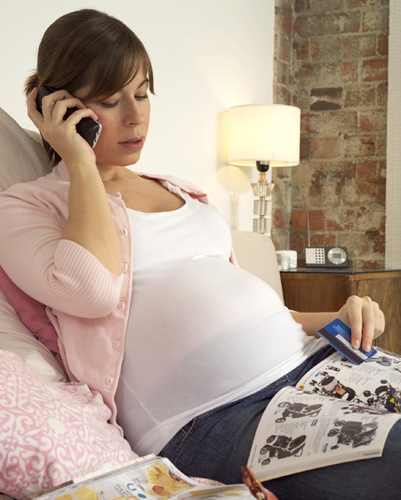You are 34 Weeks and 4 Days 38 days to go…
Inside the uterus your baby is already practicing the suckling reflex, which will enable him to feed when he’s born.
Your baby today
This 2D ultrasound has captured the moment that the baby is
sucking his thumb. Your baby is gradually learning to coordinate this
complex activity with breathing movements even though surrounded not by
air but by the amniotic fluid.

The suckling reflex is present earlier in pregnancy
but it is known from assessing premature babies that it’s usually not
until around this time that the baby is strong and coordinated enough to
suckle with ease. Your baby regularly practices suckling and this, in
combination with the rooting reflex, will enable your baby to feed.
After birth you will see
the rooting reflex as your baby turns toward anything that strokes his
cheek. The head will turn, and your baby will move his mouth in a series
of gradually diminishing circles until the object is found. Once
feeding is well established, at about four months, the rooting reflex
disappears. From this point on, your baby has much more control over the
process, able to turn and directly latch on to the nipple.
While in the uterus, there
is no chance of your baby accidentally swallowing amniotic fluid into
the lungs. The lungs are already filled with fluid and the high pressure
of this, together with your baby’s larynx, keeps out amniotic fluid.
After birth, babies have a series of reflexes designed to keep breathing
and drinking separate. To help with feeding, babies always breathe
through their nose.
… Doctor
| Q: |
My mom has offered to stay with us after the birth. Is this a good idea?
|
| A: |
Some couples prefer to get to know their baby on their own,
taking the first few days to settle in and get used to the idea of being
new parents. It’s also good to try to do things your own way when it
comes to caring for your newborn. Having said that, you’ll find an extra
pair of hands invaluable.
It really depends
on your relationship with your mom: if it’s good and you feel she’ll be
supportive, then it’s more likely to help than hinder. However, gently
establish some guidelines—namely that while you welcome her help, you’d
like to do things your way and have space to bond with your baby.
Encourage your mom toward helping around the house, rather than just
with the baby, not least so that your partner doesn’t feel excluded at
this important time.
|
Are you ready for the baby?
You may find that you soon become too tired to shop.
Try to buy items gradually, but there are certain things that it’s
worthwhile purchasing by around 37 weeks, just in case you go into
labor. First, buy those small baby-care items you’ll need right after
the birth (see Buying for your baby) plus a car seat and a Moses basket or crib. You won’t need a carriage immediately after the birth.
If going out shopping becomes difficult in late pregnancy, consider buying some items online.
By this stage of pregnancy
you may not feel up to spending hours shopping for equipment and
clothes for the baby. You can save a lot of time by getting catalogues
from the major stores and making some preliminary decisions from the
comfort of your armchair.

You are 34 Weeks and 5 Days 37 days to go…
You’ll probably find yourself analyzing every ache and pain in these final weeks of your pregnancy.
Your baby today
This is an MRI image showing a cross section of the entire
pregnancy. The mother’s spine is on the left of the image, and the baby
is lying head down within the pelvis. An MRI is rarely needed during
pregnancy, but if recommended, it is entirely safe.

By this stage of pregnancy
every time you get a twinge you may worry that it’s the onset of labor.
This is a normal concern, but try to remember that, even though you’re
heavily pregnant, most aches and pains are still likely to be due to
constipation, or stretching ligaments, rather than labor.
You may begin to
have Braxton Hicks’ contractions; these practice contractions occur as
the uterus tightens as a warm up for labor. They also help direct more
blood to the placenta in the final weeks of pregnancy. Some women are
unaware of them, while for others they can be quite uncomfortable.
Relaxing the uterine muscles by changing your position, walking around,
or taking a warm bath can help.
If you’re unsure whether the pains you’re having are Braxton Hicks’, always consult your doctor.
… Mom
| Q: |
What will I need if I’m planning to breast-feed?
|
| A: |
I found all the following items really useful when I was breast-feeding my baby:
Nursing bras that can be unclipped at the front (see image)
or have zip-open cups. Get properly fitted (bearing in mind that your
breasts will be bigger once your milk comes in). You’ll need at least
two nursing bras and, thankfully, it’s possible to get some attractive
styles. Nipple cream: this is soothing if you have cracked nipples. Breast pads
(disposable or washable). Slip them inside your bra to absorb any leaks
between feedings. Alternatively, breast shells slot inside your bra to
catch any excess milk. Breast-feeding pillow: a V-shaped pillow isn’t essential, but it will help you and your baby to get comfortable. Burp cloths to catch dribbles. Breast pump and bottles or bags for storing expressed milk.
|

Breast-feeding
If you’ve decided to breast-feed, it’s the best choice for you and your baby . However, it doesn’t always come naturally so make it easier by being prepared:
Read all about it.
If you’re expecting some of the discomforts, they won’t come as such a
shock and you may be able to take measures to prevent them. It can help,
for example, to know how to latch on your baby correctly .
Address any concerns before your baby is born: ask your doctor, or friends who’ve breast-fed.
See how it’s done
by visiting a breast-feeding group (ask your doctor to recommend one).
You may have been concerned about breast-feeding in public, so it can
help to see how discreetly it can be done. You could also ask a friend
to let you watch her position and breast-feed her baby.
Look for a lactation consultant—available from your doctor, or maybe a friend can recommend one, or contact the La Leche League for a list of counselors.
Your Rights and Benefits
Having a baby is a huge
life change and many new parents find time and money are in short
supply. Maternity and paternity leave and pay can help ease the
transition, so it’s worth finding out what you’re entitled to.
Finding out about your maternity benefits can give you peace of mind that you will have some security during your maternity leave.

Your rights
When you have a baby, you
can take up to 12 weeks off work during a 12-month period and retain
your right to return to the same, or an equivalent, position, including
equivalent pay and benefits, if you are eligible to be covered by the
Family and Medical Leave Act (FMLA). Employees eligible for FMLA have
worked for their employers for at least 12 months, including at least
1,250 hours during the previous 12 months. Additionally, the employee
must work within 75 miles of where 50 or more employees work. FMLA leave
is guaranteed unpaid, but employers or employees can opt to use paid
vacation or sick time, when this is allowed by an employer. Both men and
women are eligible for FMLA leave, which applies to private employees,
all state and local government employees, and some federal employees.
Your employer is required to continue your health insurance coverage
during your FMLA leave. If you’ve been paying a portion of your health
insurance premiums, you’ll have to continue doing so during your FMLA
leave. If you don’t want to take all 12 weeks of FMLA leave in a row,
you may be able to break it down into shorter blocks of time, or even a
shorter work week or work day. When possible, employees who are planning
to use FMLA leave are required to tell their employers 30 days before
the leave would begin. But if you have pregnancy complications that
require you to stop working before the baby is born, the 12 weeks of
FMLA leave would begin then.
Maternity pay
According to 2008 data
from the US Department of Labor’s Bureau of Labor Statistics, just 9
percent of all workers were eligible for paid family leave. According to
the Institute for Women’s Policy Research, which analyzed 2006 rankings
for America’s 100 most family-friendly employers, 93 percent of those
best-ranked companies provide at least one week of paid maternity leave,
but 52 percent of the companies pay for six weeks or less. Every
company has its own policies for maternity leave. If an employer does
provide compensation, the amount you’ll receive may depend on what you
earn and how long you’ve been working for the company. The best way to
find out what you may be eligible for is to meet with a human resources
representative or read the employee handbook. You may be allowed to use
paid sick time, vacation days, or the company’s short-term disability
coverage, in addition to paid leave.
Dads at home
Far fewer
employers offer paid paternity leave to new dads than paid maternity
leave to new moms. According to the Institute for Women’s Policy
Research, only 50 percent of 2006’s 100 most family-friendly companies
offered paid paternity leave. Of them 35 percent paid for one to two
weeks leave, and no companies paid for more than six weeks of paternity
leave. Dads who want to be home for a newborn’s earliest days may be
able to use paid vacation or sick leave, or they can take FMLA leave.
Going back to work
Before returning to work, consider the following:
Will life as a
working mom be easier if you switch to a flexible working arrangement,
such as a job share or part-time work? Give your employer ample time to
consider any request.
If
you’re breast-feeding, will your employer provide a private, clean, and
safe room for you to express milk? If not, would it be possible for you
to pump inside a bathroom stall?
You’re entitled to time off (which may be unpaid) for family emergencies.
You may be eligible for working and child tax credits, which can help with child-care costs.
Breast-feeding
Most states (47 of
them) have laws that protect a mother’s basic right to breast-feed her
child. But women still experience negative reactions when they nurse in
public. Nearly half of the states (21 of them) have laws that protect
women’s rights related to lactation and employment. Being able to pump
at work prolongs the amount of time that you can breast-feed your baby,
so these protections are important to breast-feeding moms. According to
La Leche league, during an 8-hour workday, many moms find time to pump
three times a day: during morning, lunch, and afternoon breaks. Since
time is a premium at work, many moms get by double-pumping with electric
pumps, which should supply enough milk for the following day. La Leche
League recommends that working moms should breast-feed their babies when
they are at home mornings, evenings, and weekends.
Child care
If you will be
returning to work, you will likely need child care for your baby. It is
wise to look into your child care options while you are still pregnant,
because it may take time to make a decision and some programs may have
long waiting lists. Contact a local child-care resource and referral
center for recommendations.
Some employers offer
flexible spending accounts to employees that reduce salary by a set
amount to pay for tax-preferred expenditures like day care. You won’t
pay taxes on the set-aside funds. Check with your human resources
department to see if a flexible spending account is available to you.
Maternity leave extras
Paid leave: the facts
Some states have passed laws that offer new parents paid maternity leave and, in many cases, paternity leave.
California was the first state to pass such legislation. Through its
Paid Family Leave Program, employees who participate in the State
Disability Insurance Program can receive up to six weeks of partial pay
for time off within the first year of their baby’s birth. Two other
states, Washington and New Jersey, have passed similar legislation, and
other states may follow suit. Find out about the laws in your state.
Paid leave: the facts
Better breaks for parents abroad
A recent report from researchers at Harvard University
and McGill University found the US lags behind most other countries
when it comes to paid maternity and paternity leave. Out of 173
countries studied, 168 offered working women guaranteed paid maternity
leave. The US was one of only five countries that did not, along with
Lesotho, Liberia, Papua New Guinea, and Swaziland. Sixty-six countries
offered men paid paternity leave; the US did not.
Work absences
| Q: |
If I have to take a pregnancy-related absence, will my
employer hold my job for me or will I be left without my job when I’m
ready to return to work?
|
| A: |
According to the Pregnancy Discrimination Act, employers must
hold open a job for a pregnancy-related absence for the same length of
time that jobs are held open for employees on sick leave or on
disability leave.
|
| Q: |
What happens to my eligibility for a bonus if I go on FMLA leave?
|
| A: |
You’ll still be eligible. The Family and Medical Leave Act
requires an employee to be given her same, or an equivalent, position,
and that would include eligibility for bonuses, including perfect
attendance bonuses. If you don’t miss days before or after your FMLA
leave, you will still be eligible for that bonus.
|
| Q: |
I’ve just been offered my dream job, but I’m eight weeks’
pregnant. Should I keep mum or should I say something to my new
employer?
|
| A: |
The Pregnancy Discrimination Act states that employers cannot
refuse to hire a woman because of her pregnancy or a because of a
pregnancy-related condition.
|
What you’re entitled to
Baby and child benefits
Your baby will
need health insurance coverage just like you do. When your baby is born,
you’ll need to add him to your health insurance plan so he can get the
coverage he will need. Most health insurance companies make the process
easy. Typically you’ll just need to call your health plan and tell them
your baby’s name and the date of your baby’s birth, and your baby be
automatically added to your plan. For most insurance plans, you will
have 30 days to give notice of the birth. From then on, your baby will
be covered for doctor appointments in the same way that you are.